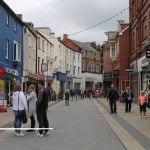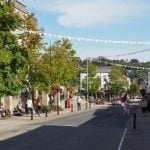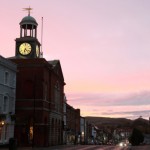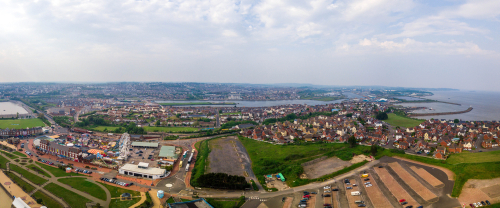
A quick guide to Barry!
Barry is a town and seaside resort in the Vale of Glamorgan, Wales, on the north coast of the Bristol Channel, approximately 10 miles (16 km) southwest of Cardiff. In 1913, Barry was operating the largest coal port in the world. It is though that Barry is named after Saint Baruc, who took up residence in the area and is buried on Barry Island. According to Office for National Statistics the population of Barry at the 2011 UK Census was 54,637.
A Fleeting History
Archaeological evidence unearthed around Barry presents proof that there was human activity in the area in the Stone Age, Iron Age and Bronze Age. There are also plenty of indications that the Romans were also very active in the area. Both St. Baruc’s Chapel and St. Nicholas Church have re-used Roman materials incorporated into their structure, a Roman villa was discovered at Llandough, and the remains of a large Roman building excavated at Glan-y-môr is believed to be a former Naval supply depot.
In 1087, following decades of insurgencies, Britain’s invading Vikings are known to have finally established a base at Barry Island. However, the Norse invaders were soon deposed by new interlopers; the Normans. They were already well established in nearby England, having been there since the victory of William the Conquer at the Battle of Hastings in 1066.
Following the Norman takeover, the region was divided into a series of manors and sub-manors. The sub-manor of Barry fell into the ownership of the de Umfraville family. They bestowed Barry to the de Barri family, who decided to eponymously name themselves after the existing name of the manor. Situated on high ground overlooking the Bristol Channel, the seat of the manor was established at Barry Castle. The castle was essentially a fortified manor house, built on a site formerly occupied by the Romans. The castle was further reinforced and extended in both in the late 13th century and early in the 14th century.
By this time, Barry had grown into a village with a small port, its own church, and a watermill. However, from the latter part of the 14th century onwards, Barry’s small population suffered a marked decline. Like much of the rest of the country, Barry endured a series of outbreaks of the ‘black death’ (aka bubonic plague). It was not until the 17th century that Barry’s population had recovered sufficiently for it to be again recognised as a village. According to the Hearth-Tax register, as late as 1673, the parish of Barry consisted of only 13 households. However, the small port became active once again with local ships travelling as far afield as France.
For the next 200 years, rural life in Barry carried on with little change. During the 1860s, the Romilly family purchased the Barry estate and were then responsible for a limited amount of ‘new build’ in and around the village. By 1871, the village reportedly consisted of 21 buildings, with little more than a 100 residents. However, massive changes were afoot, since, by this time, extensive deposits of coal and iron ore had been found in the valleys of South Wales.
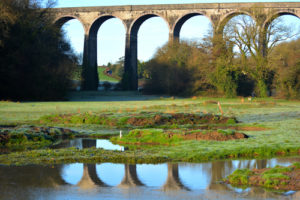
Porthkerry Viaduct is now a Grade II list structure situated in a country park
The ever-growing Welsh coal trade was far outstripping the facilities at Cardiff Docks, so a group of interested entrepreneurs got together to form the Barry Railway Company, choosing to build a new dock at Barry. Work on the new port facilities commenced in 1884, with the first dock basin opening in 1889. This was soon followed up by the opening of two further new docks and extensive port amenities. The Barry Railway transported around one million tons of coal from the South Wales Valleys to Barry Docks in the first full year of operation. The Porthkerry Viaduct which gave Barry a direct rail link with Bridgend opened in 1897 but was quickly closed due to failure of one of the embankments. It took three years to get the line open and fully operational.
By 1903, the volume of coal had climbed dramatically to over nine million tons. By this time, the port was packed with ships and there were busy ship repair yards, cold stores and flour mills centred around the docklands. By 1913, Barry was exporting more coal through its port, than any other place in the world, which peaked at 11.2 million tons.
Coal exports declined after WWI (1914-18), with strikes and the Great Depression of the 1930s causing a further downswing of the port. Barry docks proved to be an important asset during WW II (1939–45), as it became a major centre for vital imports and a landing stage for American troops. Barry’s national importance was recognised when it was made a borough in 1939, with the docks being nationalised soon after the war ended.
The Modern Era
In 1981, the road connectivity to the town’s docks was dramatically improved with the opening of the Docks Link Road, which gives direct access to the M4 Motorway. The Port of Barry is 9 miles (15km) west of Cardiff and is a key facility for the region’s chemical industry. The port handles around 300,000 tonnes of cargo, contributing over £340 million to the economy every year and supporting around 5,000 jobs. The port mostly handles timber, steel, coal, cement, aggregates and specialist liquid bulks for the UK’s chemical industry.
Barry Island (see below) has been attracting visitors ever since the 1870’s. With its great beaches and amusements its tourist numbers are as good as ever, with being especially appealing families.The recently refurbished seafront and extended promenade has done much to improve the image of the stereotypical British resort.
Barry Island
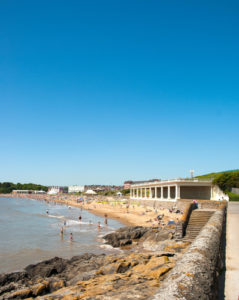
The beach at Barry Island
Barry Island is actually a peninsula, although it was an island up until the 1880s. It was then that it became linked to the mainland as the town of Barry expanded. This was especially due to the development of the docklands area by the Barry Railway Company when the construction of a new dock breached the gap between the small island and mainland. The island developed as a tourist destination over the years, greatly helped by a new train link from the mainland, completed in 1896. It dramatically increased visitor numbers as excursion trains brought thousands of people directly from the valleys. Such was the number of visitors, that over the August Bank Holiday week of 1934, more than 400,000 were recorded.
In 1966, Billy Butlin opened one of his famous Butlins Holiday Camps on Barry Island. Although always popular, the camp closed in 1986 but reopened under new management in 1987. First named ‘Majestic Barry Island’, and later renamed ‘The Barry Island Resort’, the camp suffered storm damage and then maintenance problems, during the 1990s. The camp closed for good in 1996, with the site being sold for £2.25m to Vale of Glamorgan Council, in October 1997. They demolished the camp and sold the site on to Bovis Homes, who built houses there between 2002 and 2003.
Today, Barry Island is known for its beach and Pleasure Park.
Did you know?
- The coastal region around Barry, on the Bristol Channel, has the world’s 2nd highest tidal range. The 15 metres (49 ft) reach of the tide is only greater at the Bay of Fundy in Eastern Canada.
- Much of the BBC’s popular and highly acclaimed sitcom, Gavin & Stacey, was filmed in and around Barry, particularly at Trinity Street and on Barry Island seafront.
- The ashes of notorious British serial killer, Fred West, were scattered on Barry Island after his body had been cremated on 29 March 1995.
A Famous Daughter
Julia Gillard, the 27th Prime Minister of Australia, was born in Barry in 1961. Emigrating to Australia with her family in 1966, she served as the country’s PM, between 2010 and 2013.
Getting there and around!
By Road
Getting to Barry by road is relatively easy. Simply head to the M4 on the motorway network, then turn off at Junction 33 and head for Cardiff on along the A4232. Turn right on to A4050 at Culverhouse Cross Roundabout. Just 6 miles further on you will find yourself on the northern outskirts of Barry.
By Bus
Cardiff is the nearest location from which regular national bus services run to and from the rest of the country. Cardiff is 10 miles from Barry but numerous bus and trains operate between the two locations. The national bus service at Cardiff is operated by National Express.
By Train
There are four railway stations in and around the town, which are: Barry, Barry Docks, Barry Island and Cadoxton. They are all operated and served by Transport for Wales on the Valley Lines network. Westbound services terminate at Bridgend travelling via Cardiff International Airport. Most eastbound trains terminate at Cardiff Central, but some services continue on to Merthyr Tydfil, Pontypridd or Aberdare.
By Air
Barry is located only 3 miles (5 km) to the east of Cardiff International Airport.
Getting around!
Barry is served by Cardiff Bus which operates services to Llantwit Major, Penarth, Cardiff International Airport and Cardiff City Centre, as well as operating services around the town. Barry’s main bus station is located at King’s Square in the town centre.
Things to see and do!
- Barry war museum – Located within the historic Barry Island Station the Barry War Museum is run by the Barry at War Group as part of the Barry Tourist Railway. The Barry at War Group aims to research, preserve and promote the wartime history of the town and surrounding area.
- Barry Murder Mystery Trail – two whodunnit themed outdoor trails which have clues discreetly set out along the way. One trail starts at the Barry Island Pleasure Park, passing beach cafes, funfairs, parks and lakes. The other trail follows a mainly coastal route, along the promenade and around the harbour, then goes on to ‘The Knap’.
- Amelia Trust Farm – a ‘care farm’ charity that supports disadvantaged and vulnerable people. Farm and woodlands set in 160 acres of countryside, it has over 20 species of animals, woodland trails, play area for children and a ‘farm kitchen’ café. Open every day (except Christmas day) from 10 am with last entry at 4 pm
- Fonmon Castle – built in 1180 and situated in a 340-acre rural estate, the unique home has Georgian interiors and acres of beautiful grounds, a shady dell and folly; walled gardens; an enclosed scented garden; thatched summerhouse; flower-filled secret garden; a medieval farm and grange hamlet; a nature walk and dinosaur park.
- Porthkerry Country Park – situated at the end of Cold Knap beach, it consists of 220 acres of woodland and meadows, leading to a pebble beach and spectacular cliffs. The park also has nature trails, picnic sites, a café, an adventure play area, and barbecue areas.
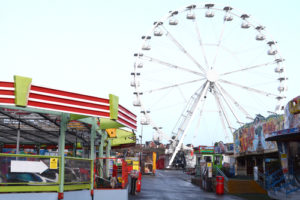
Barry Island Pleasure Beach is one of the town’s top attractions. Editorial Credit: Three-Eyed Raven Productions / Shutterstock.com
- Barry Island Pleasure Park – an amusement park situated on the coast. The park is open at weekends from Easter onwards and daily during the school summer holidays. It closes for the rest of the year in early September. The Park has more than thirty attractions, which includes amusement arcades and rides. Park entrance is free of charge.
- Barry Castle – a small Grade II listed ruin, consisting of a 14th-century two-storey gatehouse with the adjacent walls of a once large hall. There is now no trace of the original Norman manor house built by the de Barri family.
- Barry Tourist Railway – a railway line specifically developed to attract visitors to Barry. It’s a key element of the Barry Rail Centre which also features engineering and training facilities. The highlight of the journey has to be passing over the 140 m long Barry Island viaduct, which takes you to Barry Island train station.
Where to stay?
There’s a great choice of accommodation in Barry, which should suit all tastes and pockets. For those on a tight budget there’s even a small amount of very cheap hostel accommodation. A broad indication of prices for available accommodation in the Barry area, generally based on 2 people sharing, is:
Hostels: £20 – £30
B & B/Guesthouses/Standard Hotels: £30 – £70
3/4/5 Star Hotels: £70 – £180
Holiday Home/Apartments: £130 – £200 (between 2 & 6 adults sharing)


